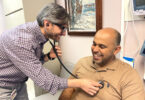Like everything in medicine, things evolve. Dr. Avery Nathens, Sunnybrook’s chief of surgery, remembers the operating room (OR) being a very protected environment with minimal foot traffic coming and going. “And over time, as our success rate for operations got better, as we became more reliant on antibiotics to prevent infections, everyone became more relaxed about managing traffic in the OR,” he says, speaking generally about the situation in many hospitals.
And now the pendulum seems to have swung too far the other way. Observational studies in several North American hospitals have found the doors leading into ORs are opened dozens of times per hour. Staff enters and leaves during various times, as do medical students and pharmaceutical representatives. And that can be a problem.
ORs are designed to be sterile environments. Air flows from the ceiling downward to keep any bacteria away from the patient. But as soon as the doors open, the airflow changes, potentially kicking up bacteria on the floor into exposed surgical wounds, increasing the risk of infection. The doors leading into ORs can take up to thirty seconds to close because many are automatic, meaning there can be a prolonged exposure to the hallway and this disrupted airflow.
So who actually needs to be in the room during surgery? “The team is not small,” says Dr. Nathens. “So typically, there may be one or two anesthetists, a surgical team can easily be three people, you might have one or two scrub nurses, one or two people circulating who need to get supplies. Then you may have the teaching component.”
Whatever the number of experts needed, he says it’s about keeping necessary people from moving around. Dr. Nathens says heavy OR traffic can also be a distraction for surgical staff, who need to keep their attention on the task at hand.
Sunnybrook is taking some proactive steps to minimize the ins and outs. They include locking some of the OR doors during crucial points in surgery, putting up posters to remind staff of the issue and scheduling students in advance to ensure they don’t rotate through inappropriately. All of these initiatives started rolling out in September.
Perhaps the most challenging part of this shift, though, will be changing the overall culture of the OR. “No one wants to tell other people to leave the room,” says Dr. Nathens. “So we are now trying to make sure everyone feels comfortable advocating for the patient, ensuring that traffic is kept to a minimum. We want to make that an expectation.”
Leading that will be various traffic control champions, like nurse Cheryl Milne, who has witnessed increasing OR traffic during the course of her career. “My part in this is to start the conversation about why are we locking the doors or why are people now phoning in? At the end of the day, patient safety is number one.”
The hope is to share successes with other hospitals, and learn from others who are also taking steps to curb traffic flow. Sunnybrook alone does about 15,000 surgeries every year, so even the smallest changes can have a big impact over time.







